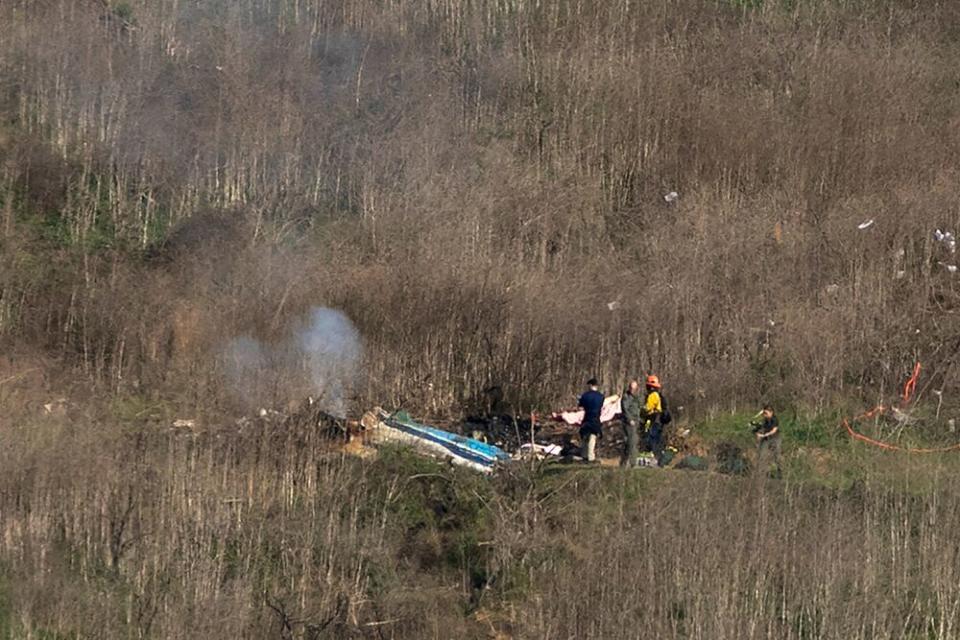Kobe Bryant's Helicopter Plunged 2,000 Ft. Per Minute in 'High Energy Impact' Crash

The National Transportation Safety Board has revealed harrowing details about the Calabasas helicopter crash that killed Kobe Bryant, his 13-year-old daughter Gianna and 7 others.
During a press conference on Tuesday, Jennifer Homendy with the NTSB announced that the aircraft plunged over “2,000 feet per minute” before crashing into a California mountain.
“We know this was a high-energy impact crash, and the helicopter was in a descending left bank,” Homendy said.
Homendy went on to share that the helicopter was not equipped with a terrain awareness and warning system (TAWS) — something she believes could have helped pilot Ara Zobayan.
TAWS is an on-board system aimed at preventing unintentional impacts with the ground. The system, which provides terrain information, could have alerted Zobayan that he was close to the hillside.
Homendy explained that NTSB introduced the idea of implementing the system years ago following a 2004 helicopter crash in Galveston, Texas, that killed 10 people. They asked that the Federal Aviation Administration (FAA) require all U.S. registered helicopters that seated 6 or more passengers be equipped with TAWS.

However, the FAA did not implement the recommendation and the proposal was closed. Homendy said the FAA has still failed to act on the advice.
The FAA did not immediately respond to PEOPLE’s request for comment.
Homendy continued, adding that the helicopter was also not equipped with a cockpit voice recorders (CVR) and flight data recorders (FDR). Like TAWS, NTSB recommended the use of cockpit voice recorders and flight data recorders to the FAA after a 2005 helicopter crash in the Baltic Sea that killed 12 people. The recommendation was also rejected, Homendy revealed.
A FDR preserves the recent history of the flight through the recording of dozens of parameters — while the CVR preserves the sounds of the cockpit, which can include conversations of the pilot.
Earlier on Tuesday, the Los Angeles County Medical Examiner said in a news release that the bodies of the nine victims were recovered.

“On Sunday afternoon, personnel from the department’s Special Operations Response Team (SORT) recovered three bodies from the helicopter wreckage located in the 4200 block of Las Virgenes Road in Calabasas,” the release said. “The next day, the search continued for the other six helicopter occupants. Soon after, their bodies were located, removed from the crash site and transported to the department’s Forensic Science Center.”
Since the announcement, the Coroner’s Office has identified Bryant, 41, John Altobelli, 56, Sarah Chester, 46, and the pilot Ara Zobayan, 50 through “the use of fingerprints.”
“Investigators identified three men and one woman who were on the aircraft,” the release states.
At this time, the Coroner’s Office is working to identify the bodies of the remaining 5 victims: Gianna, Payton Chester, Christina Mauser, Keri Altobelli and Alyssa Altobelli.
A post shared by Kobe Bryant (@kobebryant) on Sep 3, 2019 at 1:59pm PDT
Although Bryant used helicopters to get around Los Angeles, he and his wife Vanessa Bryant made a point not to fly together.
“He and Vanessa had a deal that they would never fly on a helicopter together,” a source tells PEOPLE of the couple, who tied the knot in 2001.
Bryant is survived by Vanessa, 37, and their daughters Natalia, 17, Bianka, 3, and Capri, who was born in June 2019.
The former NBA player, 41, and his daughter were on their way to a youth basketball game at the time of the crash, according to ESPN.
RELATED: Shannon Beador Mourns Coach Killed in Kobe Bryant Crash: ‘Amazing Influence on All 3 of My Daughters’
Bryant previously shared that he began using helicopters while he still played for the Los Angeles Lakers as a way to spend more time with his family — and less time stuck in traffic.
“I was sitting in traffic and I wound up missing like a school play,” he told Alex Rodriguez in 2018. “I had to figure out a way where I could still train and focus on the craft but still not compromise family time.”
“So that’s when I looked into helicopters, to be able to get down and back in 15 minutes and that’s when it started,” he added.
